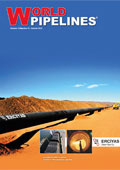Editorial comment
Transparency, accountability and delivering the goods: it’s time for a pipeline project recap. Last month the results of Nord Stream AG’s long-term monitoring operations in Finnish waters were published: the report confirmed that the construction of the two parallel Nord Stream gas pipelines caused only a minor impact on the environment. Only “local, temporary and short-term changes” were observed in areas of study such as water quality, relocation of surface sediment, change in current velocity and biodiversity of the seabed.1 The cumulative results of monitoring during 2009 – 2012 appear to rule out any concern over lasting damage to Finnish waters in the Baltic Sea. Activities such as munitions clearance, dredging, rock placement, mattress installation, pipelay, precommissioning and hyperbaric tie-in activities affected the sensitive Baltic Sea environment in a minor and temporary way.
Register for free »
Get started now for absolutely FREE, no credit card required.
Looking back at coverage of the project in World Pipelines, it is evident that the Nord Stream consortium placed great emphasis on matters of environment when in the planning stages of the project. I interviewed the Financial Director of the project in mid-2008 and afterwards I reflected that whilst the consortium was determined to make this pipeline project a viable financial reality – so key was it, in their eyes, to European energy security – they also paid much more than lip service to the concept of listening to the various environmental concerns of the Baltic states. The consortium was prepared to be fully under the microscope when it came to issues of right-of-way and environmental impact. In January 2010, the company wrote an article providing an update: the anticipated environmental scrutiny had indeed been very close, and gaining approval from the five nations involved was hard work. Nord Stream worked with authorities in Russia, Finland, Sweden, Denmark and Germany, and also included Estonia, Latvia, Lithuania and Poland in the consultation process. National permitting, the Espoo Convention processes, Environmental Impact Assessments and permits for exclusive economic zones (EEZs) were all part of the deal. Some e100 million was spent on studies and environmental planning.
The Espoo convention protocol is particularly interesting. The convention binds signatory nations to notify and consult one another on major projects likely to have a significant environmental impact across boundaries. The Nord Stream consortium’s Espoo report presented an exhaustive analysis of the Baltic Sea ecosystem and the seabed along the pipeline route. This is a groundbreaking new source of information and is available to anyone who wishes to use it in their studies (the report is available in 10 languages).
World Pipelines has since published articles on the individual parts of the pipelines’ construction (including in 2012, when Remazel Engineering provided an update on the complex pipelaying techniques that were designed for such an important project) and noticed the same precedence given to environmental factors. Nord Stream was an editor’s dream: there has always been something to say about it and the consortium was open to discussing the project in great detail, with plenty of parts of the puzzle to report on.
Transparency and giving back are both key to pipeline project success. Nord Stream has comfortably taken its place in the European energy mix and is agreed by most analysts to be a success.
With this in mind, my eye was drawn to TransCanada’s website, to a page entitled ‘What people are saying’.2 TransCanada is working on its proposed 4500 km Energy East pipeline, designed to transport 1.1 million bpd of oil from Alberta and Saskatchewan in the west to refineries and terminals in Eastern Canada. A report analysing the specific economic benefits Canadians could expect to receive from the project has been made public. On the ‘What people are saying’ page, the first comment listed is from University of Alberta Energy Economist Andrew Leach, who says, “This Energy East report is a HUGE step up in terms of transparency, clear methodology, and stated assumptions”.
It would appear the Energy East is starting out on the right foot.
- Nord Stream Gas Pipeline Construction and Operation in the Finnish EEZ, Environmental Monitoring 2012 annual report, 3rd July, 2013.
- http://blog.transcanada.com/energy-east-what-people-are-saying/ accessed 19th September, 2013.


